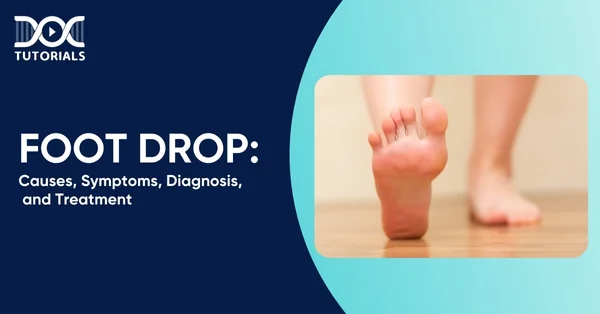Foot Drop | Causes, Symptoms, Diagnosis, and Treatment

Some people face difficulty in raising the front part of their foot. This physical condition is known as foot drop (drop foot). Foot drop is not a disease but a physical condition which arises from underlying neurological problems like multiple sclerosis (MS) or peroneal nerve damage.
While foot drop can affect both feet, it mostly affects only one foot. In most cases, the symptoms remain permanent. However, proper treatments and procedures can help improve the condition. Therefore, understanding the underlying causes, symptoms, and their treatments is crucial for NEET PG aspirants like you.
Keep reading for a detailed insight.
What is Foot Drop?
Foot drop happens due to muscle paralysis resulting from certain neurological conditions or old nerve injury. This condition restricts movement in the front part of the foot, thus making it impossible for patients to raise their feet.
The inability to raise the foot causes patients to drag their feet while walking. To avoid the drag, people lift their leg (knee) higher or swing it around to place the foot on the ground.
What are the Causes of Foot Drop?
Listed below are the common causes of foot drop:
- Lumbar Radiculopathy
The physical condition known as lumbar radiculopathy develops as a result of a pinched nerve in the lower back. L1 to L5 are the five bones that make up the lumbar spine. L5 radiculopathy is the most probable cause of the drop foot. Probable causes of lumbar radiculopathy are:
- Spinal stenosis
- Bone spurs
- Herniated disk
- Lumbar spondylosis
- Injury of the peroneal nerve
The peripheral nerve running down the leg is the common peroneal nerve. It is a branch of the sciatic nerve which runs from the back of the thigh along the front of the knee to the lower leg. The generic causes for peroneal nerve injury are:
- Ankle fracture
- Fibula fracture
- Dislocated knee
- Fractured knee
Damage to the sciatic nerve in the butt or back of the thigh can also cause a drop foot.
- Neurological or Brain Conditions
Neurological and motor neuron disorders that cause foot drop are:
- Multiple Sclerosis (MS)
- Brain stroke
- Cerebral Palsy
- Parkinson’s disease
- Motor Neuron Issues
- Polio
- Spinal muscular atrophy
- Amyotrophic lateral sclerosis (Lou Gehrig’s disease)
Besides the major foot drop causes, the others include:
- Underlying brain conditions
- Motor neuron issues
- Peripheral neuropathies
- Muscle conditions (muscular dystrophy or myositis)
What are the Risk Factors of Foot Drop?
Certain activities increase the risk of damage to the peroneal nerve, thus increasing the risk of foot drop. These factors are:
- Sitting cross-legged at the knee
- Squatting or kneeling for long periods
- A plaster cast on the leg
- Prolonged bed rest
- Severe weight loss
- Tumour or cyst on the peroneal nerve
- Diseases like rheumatoid arthritis or lupus
- Charcot-Marie-Tooth disease
- Acquired peripheral neuropathy
What are the Symptoms of Foot Drop?
Some of the common symptoms of foot drop include:
- Restricted movement of the top part of the foot.
- The patient’s inability to lift their foot makes them drag the foot while walking.
- The patient walks by raising their knee higher than average before placing the foot on the ground.
- May experience a certain limpness of the foot.
- Sensory loss in the foot
What is the Diagnosis of Foot Drop?
Doctors and healthcare professionals perform physical examinations to determine foot drop. They examine the patient’s gait and the leg muscles for weakness.
They prescribe imaging tests to look for underlying issues, such as a mass or tumour pressing on the nerve of the spine or the knee. These include:
- X-rays: To look for soft tissue mass or bone lesions.
- Ultrasound: To check for cysts or tumours on the nerves.
- Computed Tomography Scan (CT Scan): Performed to combine the X-ray images to get a clear view of the cross-sectional structures.
- Magnetic Resonance Imaging (MRI): Done to create a detailed image of the bones and their surrounding soft tissues.
Doctors recommend neurological tests, such as electromyography (EMG) and nerve conduction studies, to check and measure the electrical activity in nerves and muscles. These tests help identify the damaged foot drop nerve.
What are the Treatment Options for Foot Drop?
Treating foot drop implies treating its underlying cause. The course of it depends on the severity of the condition. The common therapies include:
- Orthotics: Braces or splints to help improve gait. One such device is the Ankle-Foot Orthosis (AFO).
- Electrical Stimulation (E-Stim): An electrical stimulation device placed near the knee sends mild signals for better muscle movement. It can help the patient walk properly.
- Physical Therapy: It helps in muscle conditioning and flexibility. It will also help with the underlying neurological condition, like MS.
Surgery: The surgical portions include:
- Tendon transfer to a different part of the foot to help restore movement in the top of the foot.
- Ankle fusion surgery is performed to fuse the foot and ankle. It relieves pressure on the surrounding muscles.
- Nerve grafting
- Peroneal nerve decompression
- Lumbar decompression involves removing minute sections of bones from the spinal disks.
Exercises: These exercises include:
- Assisted toe raises
- Ankle abduction and adduction
- Single-leg stands
- Ankle eversion and inversion
- Assisted ankle dorsiflexion
FAQs about Foot Drop
- Can a foot drop develop on both feet?
If there are underlying neurological issues in both feet, such as injury or systemic diseases, the foot drop condition can affect both sides.
- Is foot drop common?
Foot drop affects 1 in 1,00,000 people. 20% of people suffer from drop foot as a result of a stroke. Also, 23% of the general population is affected due to an L5 issue or a herniated disk.
- Does foot drop go away?
Some patients make a full recovery within a few months. However, foot drop is permanent in patients with a history of stroke or nerve damage.
- What is the first symptom of foot drop?
The primary indicator of foot drop is the inability to lift the front part of the foot. This affects how the person walks. They tend to drag their foot and walk abnormally.
Conclusion
Foot drop may not seem like a complicated condition, but there could be an underlying health issue that is causing it. Underlying nerve issues or systemic diseases can cause this physical condition. With regular checkups, physical therapy, and surgery (in severe cases), the patient’s life can improve significantly.
Platforms like DocTutorials are designed to support your learning with concise video lectures, focused quick revision programs (QRPs), and well-structured high-yield notes tailored for both exam success and clinical readiness.
Explore DocTutorials’ NEET PG course today and excel in your medical preparation.
Latest Blogs
-
-

NEET SS Exam 2024: Analysis, Key Dates, Counselling
The NEET SS 2024 exam kicked off on March 29, 2025. Over two days and two slots, candidates across 13…
-

NEET PG Registration 2025: An Essential Guide For Exam Prep
The NEET PG registration, which is conducted online, is a crucial step in the exam process. Filling out the NEET…





